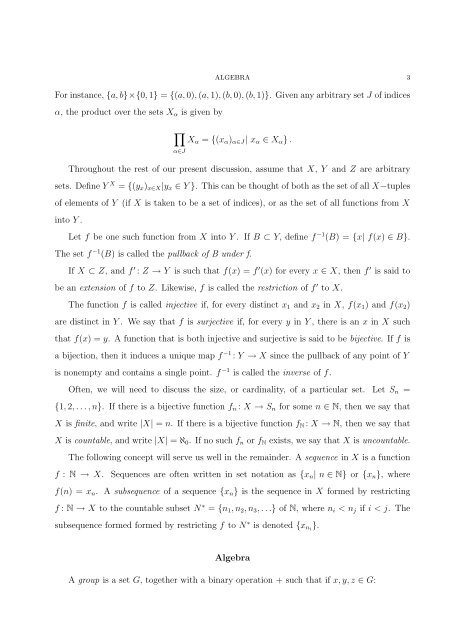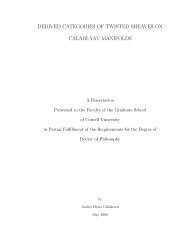FIVE MAJOR RESULTS IN ANALYSIS AND TOPOLOGY Aaron ...
FIVE MAJOR RESULTS IN ANALYSIS AND TOPOLOGY Aaron ...
FIVE MAJOR RESULTS IN ANALYSIS AND TOPOLOGY Aaron ...
Create successful ePaper yourself
Turn your PDF publications into a flip-book with our unique Google optimized e-Paper software.
ALGEBRA 3<br />
For instance, {a,b}×{0, 1} = {(a, 0), (a, 1), (b, 0), (b, 1)}. Given any arbitrary set J of indices<br />
α, the product over the sets Xα is given by<br />
<br />
Xα = {(xα)α∈J| xα ∈ Xα} .<br />
α∈J<br />
Throughout the rest of our present discussion, assume that X, Y and Z are arbitrary<br />
sets. Define Y X = {(yx)x∈X|yx ∈ Y }. This can be thought of both as the set of all X−tuples<br />
of elements of Y (if X is taken to be a set of indices), or as the set of all functions from X<br />
into Y .<br />
Let f be one such function from X into Y . If B ⊂ Y, define f −1 (B) = {x| f(x) ∈ B}.<br />
The set f −1 (B) is called the pullback of B under f.<br />
If X ⊂ Z, and f ′ : Z → Y is such that f(x) = f ′ (x) for every x ∈ X, then f ′ is said to<br />
be an extension of f to Z. Likewise, f is called the restriction of f ′ to X.<br />
The function f is called injective if, for every distinct x1 and x2 in X, f(x1) and f(x2)<br />
are distinct in Y . We say that f is surjective if, for every y in Y , there is an x in X such<br />
that f(x) = y. A function that is both injective and surjective is said to be bijective. If f is<br />
a bijection, then it induces a unique map f −1 : Y → X since the pullback of any point of Y<br />
is nonempty and contains a single point. f −1 is called the inverse of f.<br />
Often, we will need to discuss the size, or cardinality, of a particular set. Let Sn =<br />
{1, 2,...,n}. If there is a bijective function fn : X → Sn for some n ∈ N, then we say that<br />
X is finite, and write |X| = n. If there is a bijective function fN: X → N, then we say that<br />
X is countable, and write |X| = ℵ0. If no such fn or fN exists, we say that X is uncountable.<br />
The following concept will serve us well in the remainder. A sequence in X is a function<br />
f : N → X. Sequences are often written in set notation as {xn| n ∈ N} or {xn}, where<br />
f(n) = xn. A subsequence of a sequence {xn} is the sequence in X formed by restricting<br />
f : N → X to the countable subset N ∗ = {n1,n2,n3,...} of N, where ni < nj if i < j. The<br />
subsequence formed formed by restricting f to N ∗ is denoted {xni }.<br />
Algebra<br />
A group is a set G, together with a binary operation + such that if x,y,z ∈ G:
















